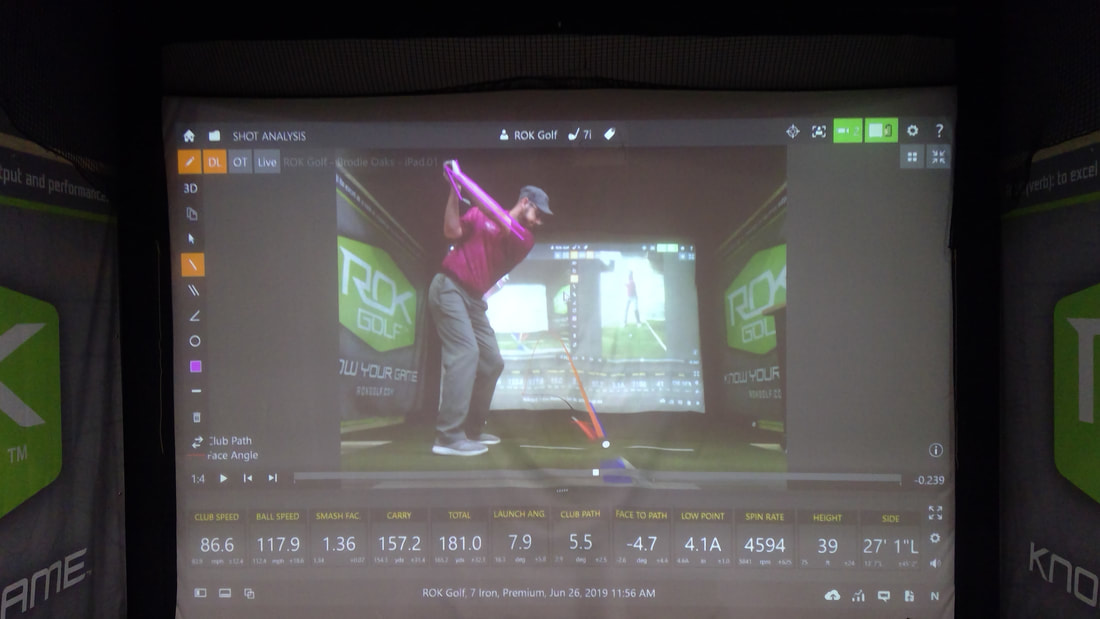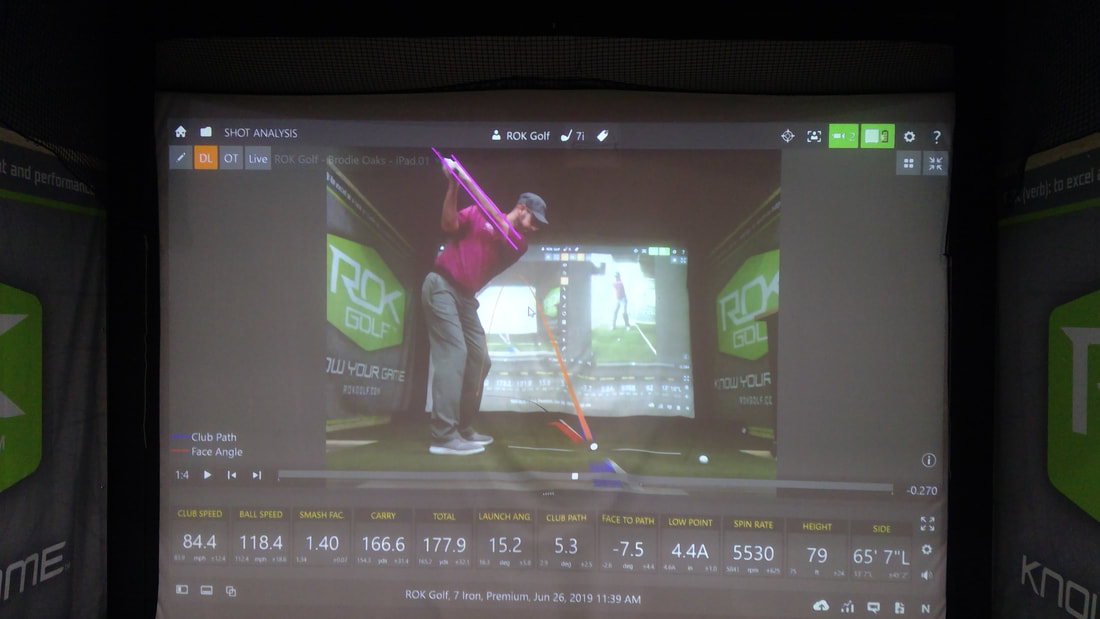|
Arms at the top By Gerald Haynes Director of Instruction - ROK Golf In this weeks installment of The Swing By Gerald we are covering the arms and the many positions that are possible during the backswing. The arms are important because they are your only connection to the golf club itself. Proper arm work can make your swing much more efficient and allow you to create more power with your legs (see last weeks blog for the lower body). When you watch the golf on TV you will see a huge variety of arms motion during the backswing and at the top of the swing. John Rahm, DJ, Brooks, Daniel Berger, and G-Mac are examples of players that have a bowed or flexed left wrist at the top. Tiger, Adam Scott, Jason Day, and Justin Thomas are players that I would consider having a flat wrist at the top. Zach Johnson, Henrik Stenson, and Nick Watney I would consider cuppy or extended at the top. All of these players, except maybe Zach Johnson, hit it prodigious distances with both irons and drivers, Zach hits it far for the lay man, but not for a tour player. The questions I get a lot are "What should my wrist look like at the top?" - "Does the wrist position really matter?" - "Why do my arms bend so much?". The answers are wide ranging and depend on many factors, the include; grip at address, wrist strength, overall flexibility, and most of all what do you want the ball to do. I will try to share some insight into some of these things for you today. Width To understand the wrist positions you first have to understand width. Width would be the distance between your hands and your body/head during your swing. Theoretically the more width you have, the bigger your swing are will be, and the more power you will create. That's not always and absolute, but is more than likely going to be the case for most players. In the picture above the player on the left has a lot of width and the player on the right has no width. Notice the space between the hands and the head on the left, I see a lot more of the swing on the right than I do the one on the left. The other thing I want you to notice is the speed and distance number on the below the swings, the one on the left will create much more speed and hit it a lot more solid than the one on the left, you can tell by the smash factor number. Keep your hands as far from your chest and head as you body will allow, at all times! The biggest reason people tend to break their arms down at the top is because of hinge, or trying to hinge too much at the top. The other factor is just a lack of body awareness, most people don't even know they break down until they see it on video. Hinge The second factor in arm position is the hinge itself. While most tour players have a lot of hinge or lag on the way down, that's not always the case at the top of their swing. Someone like Steve Stricker has very little hinge at the top, even Tiger does not have as much hinge as a guy like Zach Johnson. Zach and Steve would be on the shorter end of distance, Tiger is somewhere between them on hinge, but hits it way further then either one of them. Hinge is definitely one of the factors in Tiger hitting it further than them, but is not the only factor. On the left we have the same swing as the earlier picture, I would consider this golfer to have the correct amount of hinge. The right side golfer has too much hinge, and will have a harder time recovering to hit it solid on the way down. Both of these swings were comfortable swings for me to make as I am a recovering over-hinger. I actually created more club speed on the right, but had more ball speed and more solid contact on the left, hence more distance. I would also like to tell you how hinge affects ball flight, but I can't. In amateurs over-hingers tend to hit more fades and have more chunks, but in professionals it seems to go the other way with hooks and thin shots. I teach it on a case by case basis, and add or take away hinge based on the player in front of me, how they grip the club, what their hand strength might be, and how much width they create. John Rahm and Steve Stricker are the two guys I can think of that have very little hinge at the top, John hammers it, and Steve hits it about average. In their case lag is the determining factor, John gets hinge, but it's on the way down, and Steve keeps the same angle throughout most of his swing. Zach Johnson and Bubba Watson are the two guy I can think that have a lot of hinge at the top, Zach hit's it shorter and Bubba bombs it. So, it goes to show that, it's not always a determining factor at the top. To Flex or Not to Flex! This is probably one of the most asked about, least debated parts of the golf swing. I believe that every golfer is different, they have different hand strengths, different flexibility, different athletic ability, different body awareness. However, other than beginner's, I rarely see someone that has a flexed/bowed left wrist at the top not hit it far and consistent at the same time. Take DJ, Brooks, Berger, Hovland, Woodland, Champ, they all hit it forever and they all have a bowed left wrist. Whereas Zach, Fred Funk, Corey Pavin, Matt Kuchar are some cuppers and some of the shortest hitters on tour. The question I pose is what do you want to do? If you want to hit it really far I would probably suggest the flex/bow; if you want more control but not to hit it anywhere I would suggest some cup/extension; if you want both distance and control I would say make your wrist flat/neutral or just a little bit of cup or bow. Let's take a look at some visuals so you understand what I'm talking about. Here we have the cup/extended left wrist. This is what you would see from Zach Johnson, Henrik Stenson, Corey Pavin, Nick Watney. Look at the angle between my left wrist and forearm, that is the cup/extension. When an amateur make this motion, they tend to get the clubface open at the top, and will typically have a flip at the bottom of their swing, I will suggest fixing this early in a lesson program if it affects your distance. Hogan used this move to help him get rid of his hook and went on the win 9 majors, so it can be helpful, but not always recommended. This picture is the bowed/flexed left wrist at the top of the swing. I personally can not hit a ball with a bowed left wrist, and quite frankly it hurts like hell also. Being a recovering cupper, this move is extremely difficult for me to attain, but I can't argue with the results I see in lessons and on tour. I've seen people gain 30-40 yards when they learned how to bow their wrist, they still had to turn through, but this move takes a lot of loft off of the club at impact. The cup adds loft, the bow takes it away. When someone with a bow gets too impact they almost always have the handle leaning forward at impact, unlike the cupper who will tend to have the handle behind the ball at impact. That is important because it helps change the attack angle, the low point and how you compress the ball. I'm not saying that everyone should do this in their swing, but it is hard to argue with the results. This would be the flat/neutral wrist position at the top. I personally try to achieve this position because I get a little advantage of loft like the bow, but the control of a cup. This is the most common position you will see on tour, ala Tiger, JD, JT. This is the position I will try to get most of my students in because it's is almost the best of both worlds. From this position you can generate a good amount of power, and because you don't manipulate or move the wrist position a lot you also get a lot of control. This is the down the line view from the swing we looked at earlier with a lot of width also. When I'm warmed up, and actually paying attention to what I'm doing, I will typically hit a 7 iron about 185 yards with this swing, which isn't bad for a broken 42 year old body that doesn't practice. The other thing I like about this position, you don't have to make a big swing change to hit a draw or fade, and it's very easy to control trajectory also. This would be my recommended position for most players. Closing To surmise, I believe there is more than one way to skin a cat, sorry for the pun! There are keys to making your swing work, and once you combine a good wrist position with a strong leg position at the top, good things happen at the bottom. No everyone, myself included, can make their wrist and arms get in the same position as DJ or Brooks, but they can probably get in the same position as me or Tiger. If you can find a good combination of width, hinge, and wrist position you will be a very successful player regardless of where you start.
If you would like to learn what you do during your swing, book a lesson with us at ROK or email me at [email protected].
0 Comments
Leave a Reply. |
the rok golf teamThe ROK Golf team brings varied experience and qualifications to the golf industry. Our blog will present ideas for discussions from different perspectives. Archives
July 2019
Categories |






 RSS Feed
RSS Feed